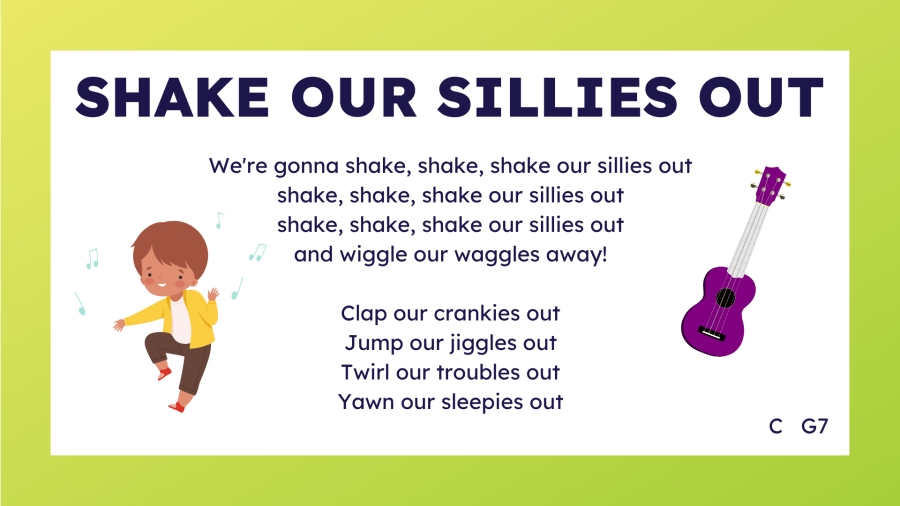Kids screaming. Soothers on the ground. Craft supplies ripped up. All part of a run-of-the-mill toddler storytime. In the 1000+ storytimes I’ve led, I’ve never had one that went “perfectly.” And that’s because toddlers are wonderfully chaotic. There’s no such thing as a perfect storytime. They’re all a little messy. Add in COVID anxiety, the excitement of meeting a big group of kids your own age for the first time, short attention spans, and the fact that none of the kids have been to an in-person storytime before? Now it’s a challenge.

Every Children’s Librarian knows the magical storytime tricks: character voices, dramatic pauses, open ended questions, tone of voice, facial expressions, use your whole body, make everything interactive etc. But those tricks did not work in my first in-person storytime since the pandemic: a free-for-all that I was not fully expecting.
In Ontario, we only recently had all COVID restrictions lifted, so even though I had ran several pre-recorded and live virtual storytimes, April 2022 marked my first in-person storytime in over 2 years. I was excited. I dusted off the purple ukulele, put together a fun lyric presentation on Canva, and picked a couple storytime go-to titles.
Then, the chaos started.

Ten excited 2 and 3 year-olds poured into the room. The normal “first day of storytime” shyness was not there. Instead, a wild “first time playing with other toddlers” mayhem replaced it. I’m not exaggerating when I say that there was a moment during the book reading when nobody was listening. Not a single person. Non of my usual classroom management tricks were working. Most of the kids did not do the actions to any song. Craft time was full of screaming and crying.
I felt like the worst librarian in the world.
Looking back I think it was a combination of a) excitement to be in a new, fun environment for the first time ever (since they were born during or right before the pandemic) and b) the confusion of never having experienced the structure of an in-person storytime. None of this was the parents or caregivers faults – they all did an amazing job trying to keep their kids safe and attentive. I quickly recognized that this was going to be my greatest Storytime challenge ever. So I made some changes to my typical approach.

Four weeks in, we had a breakthrough. Every kid sat still for the most of the story. Five weeks was even better. Every kid was doing the actions and most were singing along. Yes there are attention challenges, but with a few tricks I was able to get Storytime back on track. Here’s what I suggest:
Sit on the Floor
This is simple, but I was shocked by how impactful this was. I do all of my songs standing and moving around the room, but when I read a picture book, I normally sit in a chair. I tried sitting on the floor with the kids, and the response was game-changing. Instantly I had more buy-in, more kids sitting still and focusing on the pictures, and more reactions from them about the story. Since they were closer, it was easy to recapture their attentions when needed: “Can you point to the elephant?”
Talk to the Parents About It
On the second session I talked to parents briefly and casually about how this was completely normal behaviour for kids who had never been to a storytime before, and encouraged them that we would see improvements as the weeks went by. I think this was one of the most important things I did – I didn’t want anyone to feel like their child was “misbehaving” or causing problems. No kid or parent was doing anything wrong, we were all learning storytime skills together.

Pick Only the Most Attention Grabbing Books
Especially for the first couple weeks, do one book, and make it short with highly appealing subject matter. Dinosaurs in space. Unicorns on rainbows. Spider-man at the beach. Bonus points if it’s funny, more bonus points if it rhymes. You can pick longer books as the weeks go by, but I recommend picking the books week by week based on how the previous week went.
Incorporate Movement Breaks
You should always to this in storytime, but do it extra this time! In my storytime we go on a “Bubble Parade” at the beginning and end of the session (i.e. I walk around with the bubble machine and they follow the train of bubbles, popping as we go). I also chose songs that involve a lot of moving (Shake Your Sillies Out, Bananas Unite, Sleeping Bunnies), and when we break out the scarves for Popcorn Kernels, we start with some shaking exercises (Can you shake your scarf in a BIG CIRCLE? Can you wiggle it on the ground like a snake? Can you spin with your scarf like a tornado?) With a high energy crowd, movement breaks allow them to spend some energy instead of letting it get pent up.

Include Moments of Calm in Several Songs/Activities
Let kids pretend to go to sleep for 5 – 10 seconds during different songs to get their heartrate down and have them practice calming down. I do a verse in Shake Your Sillies Out where everyone goes to sleep and we whisper the lyrics “We’re gonna yawn, yawn, yawn our sleepies out.” I also give kids a LOT of time to “go to sleep” during Sleeping Bunnies, and paint them a picture so they can practice mindfulness: “Pretend you are a cute little baby bunny. Your fur is so soft and warm and you are very sleepy. You and all your bunny friends are cuddling together in your bunny burrow and you’re falling asleep…” We practice mindfulness again during our scarf shaking: “Pretend you are a big tall tree, standing very still. The wind blows softly on your face. Move the scarf softly like the breeze.”
Let Them Chose the Themes
I normally plan most of my storytime sessions in advance and let them chose the final theme, but this time I abandoned my plans and let them chose EVERY theme. I took suggestions every week for what topics they wanted to learn about and it helped SO much. They were much more invested in the stories and songs when it was a topic they knew they had chosen.

Do Fewer Songs and Do Them Multiple Times
This is a good tip for regular storytimes, but it applies extra here. I only do 6 – 8 songs per 45 minute storytime, and we always fill the time fully. By the 3rd session most kids know the words, and by the 4th session they recognized the upcoming song by the image on the slide. If I notice that a kid in the crowd is struggling to keep up with or learn the actions, we do the SLOW MOTION CHALLENGE where we sing the song as slowly as we can and exaggerate the actions.

Use a PowerPoint with Lyrics and Images
I do this every time (learn more in this blog post about How I Levelled Up My Toddler Storytime), and I highly recommend trying it especially now that attention spans are a challenge. Putting the lyrics on screen helps increase parent participation and using related images helps kids stay on track with the structure of storytime. Here are my slides from the Tigers Theme. I present this in Canva with animations included, but it could work as static images as well:
All in all, you can do this! My advice to anyone trying their first in-person storytime since COVID is to expect the first couple weeks to be very challenging, but don’t lose hope. Keep your enthusiasm high, get to know the kids, and reassure parents that things will improve.
How are you finding your in-person storytimes these days?
___
p.s. YES, I’m BACK! My last published blog post was from December 2020, and that’s because for a year I took on a non-programming role at my library! I was working as the Communications Specialist doing social media management, re-branding, design work, radio interviews, and press releases. As much as I enjoyed that creative challenge, I am happy to be back in a programming role as a Programming and Outreach Librarian. I have a lot of projects on the go, and a lot of programs coming up this summer, so stay tuned for more posts. I missed being the Ontarian Librarian!
Here’s a picture of my dog to make up for being quiet for the past couple years!

